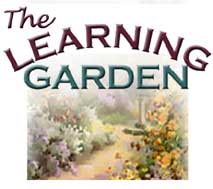
From Seed to Seed:
Plant Science for K-8 Educators
 |
From Seed to Seed: |
|
|
Apical meristems. At the tip, or apex,
of each stem and root is an apical
meristem. Cell division at the apical meristem contributes to
the lengthening of these plant parts. This lengthening is termed primary
growth, and it takes place in tender, young tissues.
 A new seedling reaching for the sky, roots penetrating the soil in search
of water-these are examples of primary growth. In addition to lengthening
the plant body, the shoot apical meristem perpetually produces leaf and
bud primordia, which develop into leaves and lateral shoots, respectively.
A new seedling reaching for the sky, roots penetrating the soil in search
of water-these are examples of primary growth. In addition to lengthening
the plant body, the shoot apical meristem perpetually produces leaf and
bud primordia, which develop into leaves and lateral shoots, respectively.
One type of lateral meristem is the vascular
cambium. The vascular cambium The cork cambium
is a second type of lateral meristem. It lies closer to the surface than
the vascular cambium, and produces the outer bark. The outer bark is composed
mostly of cork tissue. Cork is a collection of dead cells that replaces
the epidermis in woody stems.
Intercalary meristems. In most plants, the primary meristem
is located at the tip of the growing shoot-we're all familiar with the
rapid growth of a morning glory vine,  bison,
and other herbivores. Plants with apical meristems would repeatedly lose
their growing points and therefore their primary means of regenerating.
Grasses, however, adapted by locating their meristem tissue at nodes along
the stem, just above ground level. Grasses continue to grow from these intercalary
meristems and can repeatedly renew themselves after grazing by animals
(or mowing by humans!) bison,
and other herbivores. Plants with apical meristems would repeatedly lose
their growing points and therefore their primary means of regenerating.
Grasses, however, adapted by locating their meristem tissue at nodes along
the stem, just above ground level. Grasses continue to grow from these intercalary
meristems and can repeatedly renew themselves after grazing by animals
(or mowing by humans!)
Now we know how plants grow. But plants move and change and react in other ways besides simply growing larger. It is easy to overlook these changes, however, because "plant time" usually moves much more slowly than "human time." Let's take a look at the other ways that plants grow and change. |
||||
|
Made possible by a grant from Oracle Corp. Copyright 2001, National Gardening
Association, Inc. For questions regarding this web site, contact Webmaster |